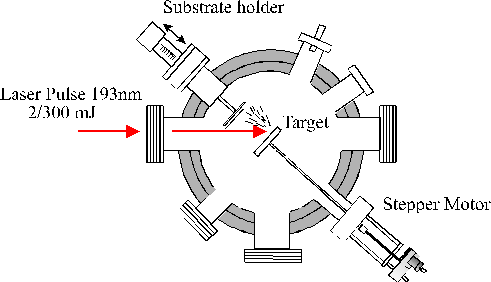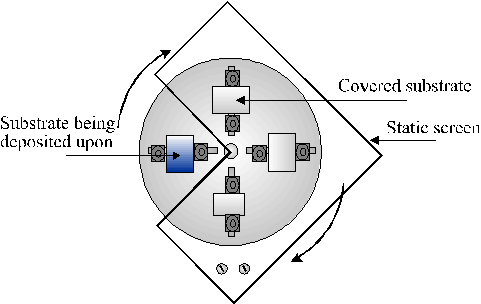
Film Depostion

Below is a schematic plan view of the ablation chamber. An excimer laser (Lambda Physik, Compex 201) charged with ArF (193 nm) with a typical pulse energy of 2/300 mJ is focussed using a fused silica lens (f.l.=27 cm) onto the target mounted in a stainless steel vacuum chamber maintained at ~10-6 Torr. The are of the focal volume has been estimated by stylus profilometry to be ~ 1 x 0.4 mm2.

The target takes the form of a 50 mm disk, it is mounted on a shaft attached via a double 'O' ring seal to a stepper motor. This enables the target to be rotated during ablation to prevent deep crater formation, allowing longer deposition times and reducing the number of large particulates being sputtered from the target and being incorporated into the films.
In earlier experiments the target took the form of a cylindrical rod suspended vertically from the lid of the vacuum chamber, and translated and rotated via a stepper motor. The shot-shot reproducibility of such an arrangement is extremely sensitive to any eccentricity in the rod rotation. Thus the present set-up employs a side mounted rotating disk with the laser normally incident at an angle of 45°.
Films are deposited on various substrates, including single crystal silicon, quartz and NaCl each ~1 cm2 in area. The substrate holder allows the target substrate distance to be varied between 30 and 60 mm by means of a micrometer and bellows arrangement. The substrate holder is mounted on a 360° rotatable flange, this allows up to four film to be deposited independently by rotating the samples behind a static screen.

Back to Experimental set-ups.
Back to Laser Ablation Homepage.
Back to :-
![]() Bristol University Chemistry Home Page.
Bristol University Chemistry Home Page.